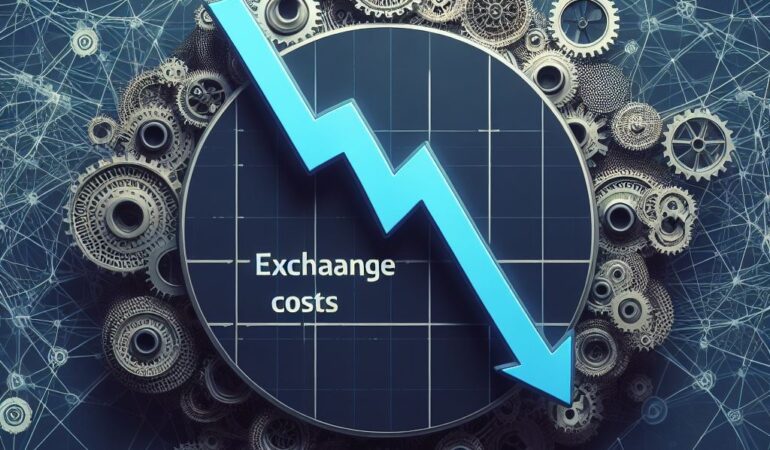Looking to cut exchange costs efficiently? You’re not alone. With the average business spending 1-3% of their revenue on exchange expenses, finding ways to save is vital.
Fortunately, there are proven tactics that can help. By conducting a thorough audit, optimizing exchange rate management, streamlining processes with automation, negotiating better rates, and implementing cost-effective currency hedging strategies, you can significantly reduce your exchange costs.
In this article, we’ll explore these tactics and show you how to save.
Key Takeaways
- Conduct a thorough audit and review of all exchange-related expenses
- Stay updated on global economic trends and utilize market analysis tools to manage exchange rates
- Automate exchange processes to increase efficiency and reduce human error
- Negotiate with exchange providers to secure better rates and explore bundled services for cost savings
Conduct a Thorough Audit of Exchange Expenses
To efficiently cut exchange costs, start by conducting a thorough audit of your expenses. This step is crucial in identifying areas where you can reduce unnecessary spending and optimize your budget. Begin by gathering data on all exchange-related expenses, such as transaction fees, transfer fees, and currency conversion charges. Look for patterns and trends in your spending to pinpoint areas that require attention.
Analyze your current exchange service providers and compare their fees and rates against competitors in the market. This will help you determine if you’re getting the best deal or if it’s time to switch providers. Additionally, review your payment processes and identify any inefficiencies that may be costing you extra.
Consider implementing technology solutions that can streamline your exchange processes. Automated systems can help reduce manual errors and decrease the time spent on each transaction. Look for platforms that offer competitive rates, low fees, and robust reporting capabilities to track your expenses and identify opportunities for further cost savings.
Optimize Exchange Rate Management
Now, let’s delve into optimizing your exchange rate management to further cut costs efficiently. Here are four proven tactics to help you achieve this:
- Monitor market conditions:
- Stay updated on global economic trends, political developments, and currency fluctuations that can impact exchange rates.
- Utilize market analysis tools or consult with experts to make informed decisions.
- Implement hedging strategies:
- Hedging allows you to lock in exchange rates for future transactions, reducing the risk of adverse rate movements.
- Explore options such as forward contracts, currency options, or currency swaps to mitigate exchange rate volatility.
- Negotiate with financial institutions:
- Engage with your bank or payment provider to negotiate better exchange rates and lower transaction fees.
- Compare rates offered by different institutions and leverage your business volume to secure more favorable terms.
- Opt for multi-currency accounts:
- Maintain accounts in different currencies to minimize currency conversion costs.
- This enables you to receive and make payments in the local currency, avoiding unnecessary fees and exchange rate markups.
By optimizing your exchange rate management through these tactics, you can significantly reduce costs and improve your bottom line.
Now, let’s explore the next section on how to streamline exchange processes with automation.
Streamline Exchange Processes With Automation
By automating your exchange processes, you can streamline operations and further enhance cost-cutting efforts. Automation eliminates manual tasks, reducing the potential for human error and increasing efficiency. With the use of technology, you can automate tasks such as data entry, reconciliation, and reporting, saving time and resources.
Automating exchange processes also allows for real-time monitoring and analysis of market trends and fluctuations. By leveraging data analytics tools, you can gain valuable insights into exchange rate movements, enabling you to make informed decisions and optimize your exchange operations. This data-driven approach helps you identify patterns and trends, allowing you to take advantage of favorable exchange rates and minimize risks.
Furthermore, automation enables seamless integration with other systems and platforms, such as accounting software or customer relationship management (CRM) systems. This integration streamlines the exchange process, reducing the need for manual data transfer and enhancing overall productivity. It also facilitates accurate and timely reporting, providing you with a comprehensive view of your exchange operations.
Negotiate Better Rates With Exchange Providers
Start by leveraging your negotiating skills to secure better rates with exchange providers. Negotiating better rates can significantly reduce your exchange costs and increase your overall profitability.
Here are four proven tactics to help you negotiate better rates with exchange providers:
- Research and compare: Before entering into negotiations, thoroughly research different exchange providers in the market. Compare their rates, services, and reputation. This will give you a better understanding of the competitive landscape and enable you to negotiate from a position of knowledge and strength.
- Highlight your value: Clearly communicate the value your business brings to the exchange provider. Emphasize your track record, volume of transactions, and potential for future growth. By demonstrating the potential benefits of a long-term partnership, you can negotiate more favorable rates.
- Build relationships: Cultivate strong relationships with exchange provider representatives. Attend industry events, engage in networking opportunities, and seek to understand their challenges and goals. Building a rapport can lead to more flexible negotiations and better rates.
- Explore bundled services: Many exchange providers offer a range of services beyond just transaction processing. Investigate whether bundling additional services, such as data analytics or risk management tools, can lead to better rates. By leveraging multiple services, you can negotiate a more comprehensive and cost-effective package.
Implement Cost-Effective Currency Hedging Strategies
How can you effectively implement cost-effective currency hedging strategies to cut exchange costs?
Currency hedging is a risk management strategy used to protect against fluctuations in exchange rates. By implementing cost-effective currency hedging strategies, you can minimize the impact of exchange rate movements on your business and reduce exchange costs.
One cost-effective currency hedging strategy is forward contracts. These contracts allow you to lock in an exchange rate for a future date, protecting you from any adverse currency movements. By entering into a forward contract, you can secure a favorable exchange rate and avoid the need to make spot transactions at potentially unfavorable rates.
Another effective strategy is using currency options. With options, you have the right but not the obligation to exchange currency at a predetermined rate. This gives you flexibility and allows you to take advantage of favorable rate movements while limiting your downside risk.
Additionally, diversifying your currency exposure can help reduce exchange costs. By holding a portfolio of different currencies, you can offset losses in one currency with gains in another. This can help protect your business from adverse exchange rate movements.
Frequently Asked Questions
What Are Some Common Mistakes to Avoid When Conducting a Thorough Audit of Exchange Expenses?
When conducting a thorough audit of exchange expenses, avoid these common mistakes: neglecting to analyze historical data, not involving key stakeholders, failing to consider all costs and fees, and overlooking potential cost-saving opportunities.
How Can Businesses Ensure They Are Optimizing Their Exchange Rate Management Effectively?
To optimize your exchange rate management effectively, analyze market trends, set clear objectives, and implement a risk management strategy. Regularly monitor exchange rates, leverage technology, and consider outsourcing to experts for cost-effective solutions.
What Are Some Key Benefits of Streamlining Exchange Processes With Automation?
By streamlining exchange processes with automation, you can enjoy key benefits such as increased efficiency, reduced manual errors, improved accuracy, and faster transaction times. These advantages can ultimately lead to cost savings and better financial management.
What Strategies Can Be Used to Negotiate Better Rates With Exchange Providers?
To negotiate better rates with exchange providers, focus on building strong relationships, demonstrating your value, and exploring alternative options. Analyze data, negotiate contracts, and leverage competition to drive down costs and increase savings.
Are There Any Specific Challenges or Considerations to Keep in Mind When Implementing Cost-Effective Currency Hedging Strategies?
When implementing cost-effective currency hedging strategies, keep in mind the challenges and considerations. Ensure you have a clear understanding of market volatility and the impact on exchange rates to make informed decisions.




